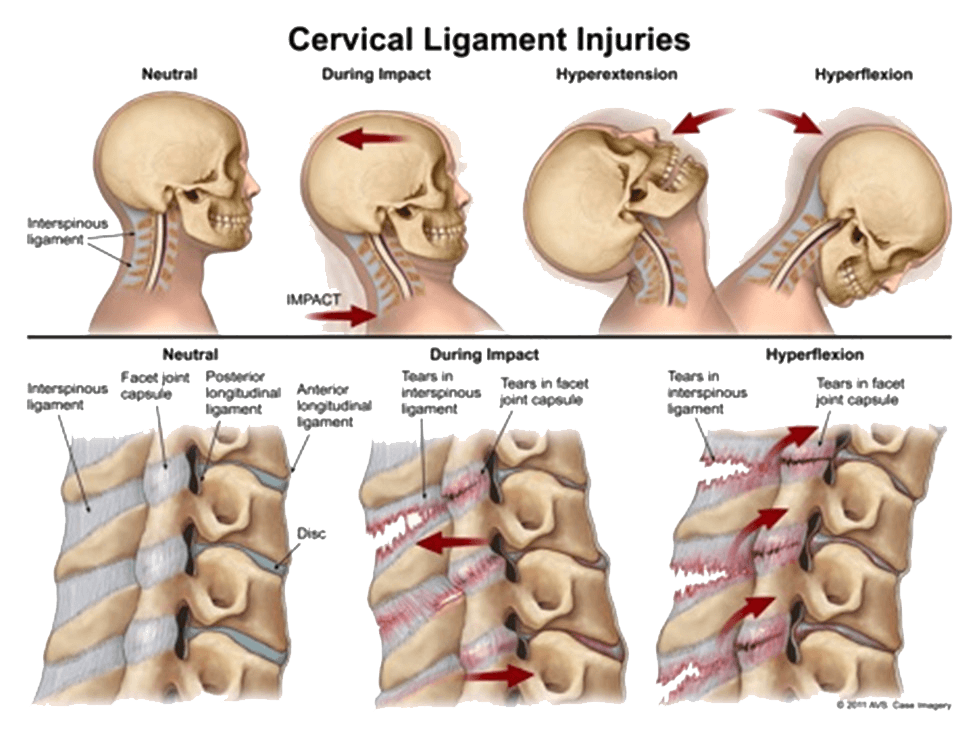Whiplash is when someone’s head moves forwards and then backwards quickly, resulting in joint compression, ligament damage and muscle guarding leading to pain and stiffness with movement. This often happens in car crashes but can also occur as a result of a sports injury.
Whiplash
What is whiplash?
Symptoms of Whiplash
Symptoms may be experienced immediately but often develop after a day and can include:
- Pain And Aching Into The Back, Neck And Shoulders.
- Pain May be With Some Or All Movements Of The Neck And Back.
- Headache, Visual Disturbance Or Tinnitus (Ringing In The Ears).
- Pins And Needles Or Referral Of Pain Into The Arms.

Do I need an X-Ray?
Following a motor vehicle accident, your GP/Physiotherapist will send you for an x-ray if:
- You are 65 years of age or over
- The accident was dangerous (For Example high speeds> 100km/hr, car rolled over, ejected from the vehicle, or a bicycle crash)
- Unable to rotate your head 45° to the left and right
A CT and MRI scan may be indicated 2-4 weeks after the accident if there is persistent neck pain or pins and needles/ numbness/ hot or cold sensations in the arms indicating there is pressure on a nerve in your neck.
Initial Management
Once severe injury has been eliminated, initial management in the first 24-48 hours includes rest and avoidance of aggravating activities to allow the damaged tissue to settle. Heat and anti-inflammatory medication are useful in managing your symptoms.
Treatment
Book in to see a Physiotherapist or Chiropractor at Masnad Health Clinic who will commence gentle hands on techniques and prescribe you with an exercise program to restore the movement of your neck. You should expect some level of discomfort with these exercises but remember they should not cause severe pain.
When should I start Physiotherapy or Chiropractic Treatment?
The first three months post injury is the most crucial timeframe. As soon as you are able to get yourself to a Physiotherapist or Chiropractor after the accident the better your recovery!
What can I do to speed up my recovery?
- Try to stay active and continue with your normal daily activities
- Continue going to work if you can. People who stay at work after an accident recover more quickly than those who take time off!
- Do not use a collar unless it’s recommended by your GP or Physiotherapist. Collars used to be standard protocol for Whiplash injuries, howevernew evidence shows that active treatment is much better and wearing a collar slows down your recovery
- Perform the exercises prescribed by your Physiotherapist
Tips & Tricks for Managing Daily Activities
- Initially avoid heavy lifting. Divide heavy loads into several lighter loads for carrying.
- When sitting, change your posture regularly, stand up for a break at regular intervals and perform gentle exercises regularly throughout the day.
- Ensure correct seat setup and sitting posture when at work, sitting at a computer or when driving.
- Spread out tasks and rotate them to prevent over straining
- Bring objects closer to you. For example, lower the clothes line to reduce the strain on your neck and shoulders when hanging clothes, kneel to weed the garden rather than bending over.
How long till I get better?
Most people are able to continue with their normal activities, but it may take weeks or months for the discomfort to go away completely. Every injury is different.
Take Home Message:
- See your GP or Physiotherapist as soon as you can
- DO NOT wear a collar or stay in bed and cease all activities
- Try to stay as active as you can without causing severe pain

New Client Offer - 10% OFF
Are you in pain? Not sure if we can help you?
Book your initial appointment and receive 10% off any service!